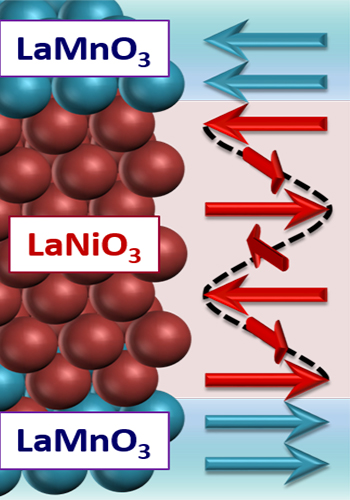Generation of "tailored" magnetic materials

Every day, new technologies require more precision in the intrinsic properties of the materials used. To meet increasingly specific requirements, physicists are interested in a generation of artificial materials, the properties of which can be controlled. Researchers at the University of Geneva (UNIGE), Switzerland, in collaboration with French and English teams, have succeed in manipulating the properties of two oxides which make up the artificial material, more exactly they managed to modify the magnetic properties which can be either ferromagnetic or antiferromagnetic; that is, with or without net magnetic moment. The scientists have demonstrated, in their study published in Nature Communications, that they are able now to control the magnetism in this type of materials and that they could, in the near future, offer tailored materials for the devices of tomorrow.
When two materials are in contact, they interact in different ways and, sometimes, exchange electrons. But what happens when one stacks up ultrathin layers, of the order of one nanometer? «We have combined two materials, LaNiO3, a metallic paramagnet (without magnetic order), and LaMnO3, an insulating antiferromagnet, by alternating a layer of the first, then of the second, etc. We then observed what the influence of interactions at the interfaces was and we noticed a profound change in the intrinsic properties of the two materials», said a statement from Jean-Marc Triscone, professor at the Department of quantum matter physics in the Faculty of Science of UNIGE.
LaNiO3 and LaMnO3 have the same cubic crystalline structure, and thus the researchers can stack the elemental unit cells of these compounds, that is the small “cubes” made of just a few atoms, by using state-of-the-art technology. They then manage to create an artificial structure with a perfect alignment of the unit cells. To do this, the physicists deposit one unit cell after the other on a substrate; that is a small heated crystal tile. The layers are very thin and their thickness of about a nanometer is controlled precisely at the unit cell.
Goldsmith precision
«In order to realise a perfect structure on the crystal tile, we had to find the exact temperature and pressure conditions required to grow the materials one on top of the other. Then we investigated the properties of the interfaces depending on the number of layers stacked», explain Marta Gibert, researcher in physics at UNIGE and first author of the study. «Measurements of the physical properties then revealed that the properties of LaNiO3 are very different when in contact with LaMnO3. From being a metal without magnetic order, it becomes not only magnetic but also insulating. Moreover, the overall properties of the artificial material depend on the individual thickness of the layer of each material and they can also change as a function of the chosen thickness», added the physicist.
Thanks to this discovery, the researchers are therefore able to control the magnetic state of these materials – a track to build artificial tailored materials according to specific needs in the future. Such control of the magnetic interactions could especially be used to develop future magnetic memories, allowing the high dissipation energy of current processors to be reduced.
This research is not limited to magnetic materials, but it is also of interest for materials that are simultaneously magnetic and ferroelectric, another way to new memories or even to superconducting materials working at higher temperatures – a dream which may be not so distant.
Contact: Marta Gibert, +41 22 379 32 47
11 Apr 2016